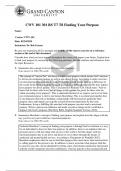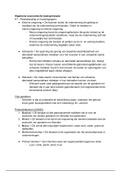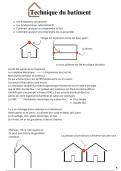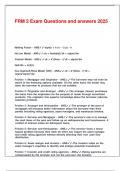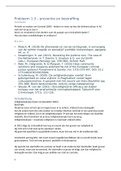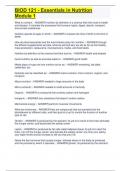Answers
What is trephination or trepanning, why is it done? What cultures was it known in? What
do we know about the 'theory' cultures used to justify trepanning? - answer
Trephination/trepanning is when you make purposeful holes in a skull to reduce swelling
in the brain. By making holes in the skull, it relieves pressure in the brain. Survivor had
holes but had healing around the holes so it was made purposeful. It was during the
prehistoric era, possibly Hippocratic.
What were the two theories about the structure where behavior originates? What theory
was held by Hippocrates? Aristotle? - answer Two theories :
Cardiac Hypothesis [Aristotle / Structure]: Behavior originates from the heart.
- Heart is red, warm = behavior being warm
- Brain is grey, cold = Love doesn't come from there
Brain Hypothesis [Hippocrates+Galen / Function]: Behavior originates from the brain.
Hippocrates
- When the head is injured, the other side stops moving (left side of the head, right side
can't move)
Brain -> move! = Behavior!
Galen
- Nerve from eyes and nerve from ears go to the brain and NOT the heart
Brain is the origin of behavior
Pressure on open brain causes movement to stop/death
What did humor theory and ventricular theory aim to explain? Who held the humor
theory (2 people that we mentioned). - answer Humor Theory [Hippocrates+Galen]:
Four Fluids (humors) in your body determines who you are and what you do!
- Blood: Too sanguine leads to blood letting
- Yellow Bile: Too much means you are choleric (easily angered
- Black Bile: Too much = melancholic
- Phlegm/Mucus: Too much = Phlegmatic (Calm/rationally deal with problems without
getting upset)
Balance of the Four = Healthy!
Ventricular Theory: Brain has three cavities called Ventricles. Made via Leonardo Da
Vinci. Takes Aristotle's views of faculties and sticks them in these ventricles
What was Galen's knowledge of anatomy based on? How did Andreas Vesalius
improve upon this, how was he able to do so? - answer Galen's knowledge of
anatomy was based on the Middle East and based on apes.
,Andreas Vesalius wanted to find out how the body was put together and begged the
church, eventually got permission to get bodies of executed criminals (going to hell
anyway)
Proved Galen wrong
What is phrenology and its relation to localization of function? Who were the first two
men famous for holding to localization of function in its weird variation? Who were
famous for bringing evidence for localization of function in its non-weird variation? -
answer Phrenology: Can tell from the outside that someone is particularly aggressive
or passive based on small bumps on the head, bs. Based on physical parts of the head.
First people to bring it up: Franz Gall and Johann Spurzheim
Broca & Wernicke:
Broca: Found a lecture by someone who said they thought the ability to speak was
located in front of the brain
- Patient: Left side of brain damage and couldn't speak at all
- Found that there was major damage to the purple area. Evidence that the area in the
brain was heavily involved in speech
Wernick: Patients damaged there couldn't speak either!
- Both areas were involved in language but in different ways.
What is equipotentiality? What led Flourens to hold the view of equipotentiality of
function in the brain? What is mass action and what led Karl Lashley to hold the mass
action view of function in the brain? - answer Brought up by Pierre Flourens
- Used animals instead of patients
- Caused damage in parts of the brain in animals but recovere dunless severe damage
-> Other bits of the brain seems to be able to take over! One part is damaged? other
parts compensate!
Karl Lashley
- Mass Action: The efficiency of any complex function of the brain is reduced
proportionately to how much damage the brain as a whole has sustained, but not to the
damage of any particular area of the brain.
What view did Hughlings Jackson propound w.r.t the organization of the nervous
system? - answer Hierarchy of organization
Lower level functions are needed for middle / high levels
- Unit 1: Keeps your alive (heart beat, lungs breathing)
- Unit 2: All parts of the brain that collect information from the outside world and
integrate it
- Unit 3: Uses that information to act
, What was Luria's view on the organization of the nervous system? - answer -
Synthesis of localization of function with equipotentiality
- Damage bits here and there, but within a unit, there is equipotentiality
- Unit 1 does basic stuff to keep you alive, unit 2 which takes all information and
integrates it into usable info. unit 3 takes that and decides what you're gonna do!
What is the distinction between the central and peripheral nervous system? - answer
Central Nervous System: Encased in Bone
Peripheral Nervous System: not encased in Bone
What parts comprise the central nervous system? - answer Central Nervous System:
Encased in Bone
- Brain
- Spinal Cord
What is the difference between the somatic and autonomic nervous system? - answer
- Somatic Nervous System
- Voluntary - Sensory/motor
- Autonomic Nervous System
- Involuntary / heartbeat / breathing
Explain the difference between efferent and afferent fibers? - answer - Somatic
Nervous System (Sends info to muscle to wave, kick, write / information going from
brain / spinal cord to your hands)
- Afferent: Enter
- Sensory
- Efferent: Exit
- Motor commands
- Autonomic Nervous System
- Afferent - Enter Sensory
- Efferent - away Motor
- Parasympathetic Nervous System
- Sitting in front of TV / Making sure food gets digested, heart rate is low
- Sympathetic Nervous System
- Increased Heart rate / fight or flight response
How are the directions ventral, dorsal, rostral, caudal, medial, lateral, superior, inferior,
anterior and posterior used? - answer Dorsum = back 🡪 dorsal
Venter = stomach 🡪 ventral
Cauda = tail 🡪 caudal
Rostrum = snout/beak 🡪 rostral
Anterior = in front
Posterior = behind
Superior = above/upper


